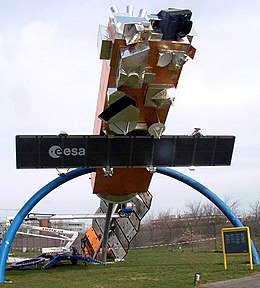
Back إنفيسات Arabic Envisat Catalan Envisat German Envisat Spanish Envisat Estonian انویست Persian ENVISAT-1 Finnish ENVISAT French Envisat Galician Envisat ID
 Model of Envisat | |
| Mission type | Earth observation |
|---|---|
| Operator | ESA |
| COSPAR ID | 2002-009A |
| SATCAT no. | 27386 |
| Website | envisat |
| Mission duration | Planned: 5 years Final: 10 years, 1 month, 6 days |
| Spacecraft properties | |
| Manufacturer | Astrium |
| Launch mass | 8,211 kg (18,102 lb) |
| Dimensions | 26 × 10 × 5 m (85 × 33 × 16 ft) |
| Power | 6,500 watts |
| Start of mission | |
| Launch date | 1 March 2002, 01:07:59 UTC |
| Rocket | Ariane 5G V-145 |
| Launch site | Kourou ELA-3 |
| Contractor | Arianespace |
| End of mission | |
| Disposal | None |
| Declared | 9 May 2012 |
| Last contact | 8 April 2012 (spacecraft failure) |
| Decay date | ~150 years |
| Orbital parameters | |
| Reference system | Geocentric |
| Regime | Polar low Earth |
| Semi-major axis | 7,144.9 km (4,439.6 mi) |
| Eccentricity | 0.00042 |
| Perigee altitude | 772 km (480 mi) |
| Apogee altitude | 774 km (481 mi) |
| Inclination | 98.40 degrees |
| Period | 100.16 minutes |
| Repeat interval | 35 days |
| Epoch | 15 December 2013, 03:07:00 UTC[1] |
| Instruments | |
Envisat ("Environmental Satellite") is a large Earth-observing satellite which has been inactive since 2012. It is still in orbit and considered space debris. Operated by the European Space Agency (ESA), it was the world's largest civilian Earth observation satellite.[2]
It was launched on 1 March 2002 aboard an Ariane 5 from the Guyana Space Centre in Kourou, French Guiana, into a Sun synchronous polar orbit at an altitude of 790 ± 10 km. It orbits the Earth in about 101 minutes, with a repeat cycle of 35 days. After losing contact with the satellite on 8 April 2012, ESA formally announced the end of Envisat's mission on 9 May 2012.[3]
Envisat cost 2.3 billion Euro (including 300 million Euro for 5 years of operations) to develop and launch.[4] The mission has been replaced by the Sentinel series of satellites. The first of these, Sentinel 1, has taken over the radar duties of Envisat since its launch in 2014.
- ^ "ENVISAT Satellite details 2002-009A NORAD 27386". N2YO. 15 December 2013. Retrieved 15 December 2013.
- ^ EarthNet Online
- ^ "ESA declares end of mission for Envisat". ESA. 9 May 2012.
- ^ European Space Agency web-site
© MMXXIII Rich X Search. We shall prevail. All rights reserved. Rich X Search